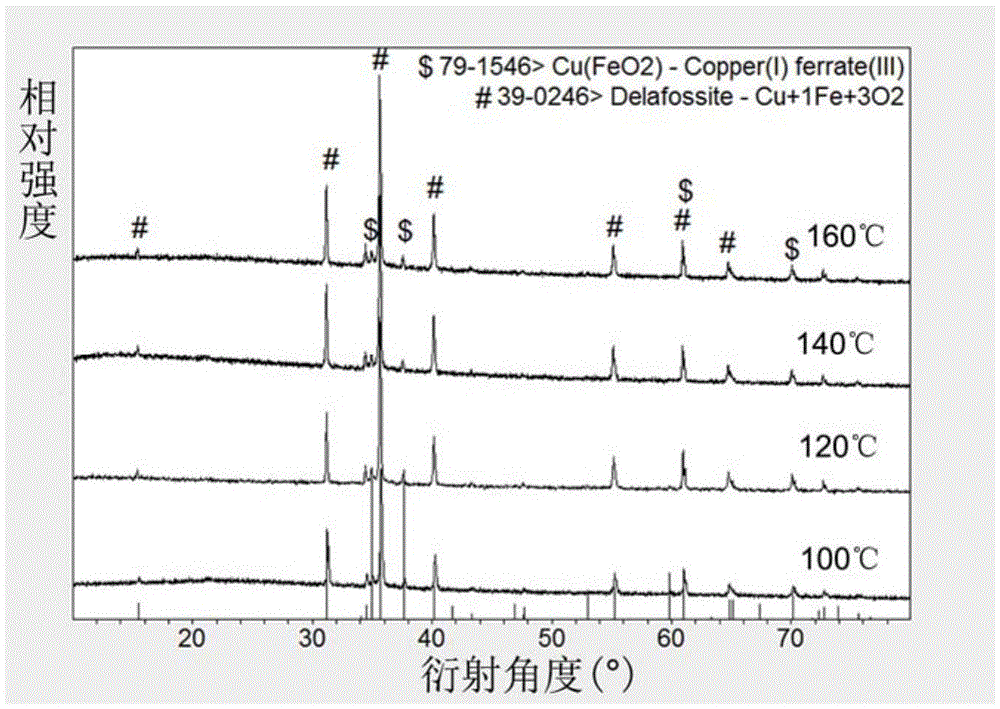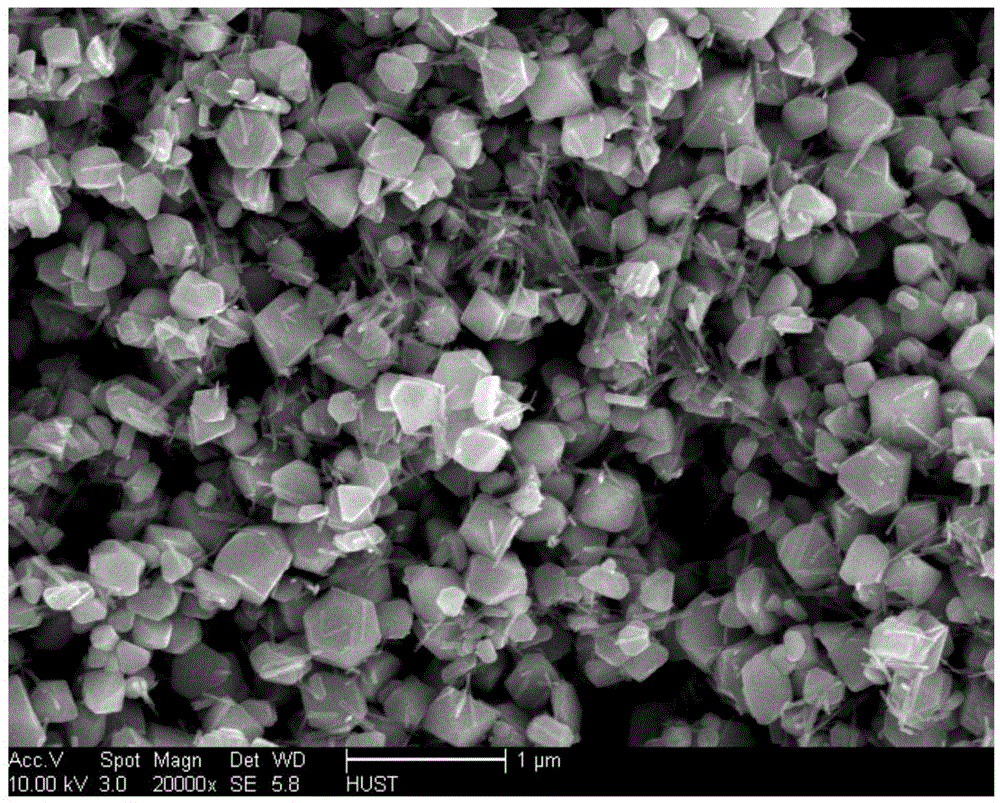A kind of low-temperature preparation method of delafossite structure cufeo2 crystal material
A technology of crystalline materials and delafossite, applied in nanotechnology, chemical instruments and methods, iron compounds, etc. for materials and surface science, can solve the problem that the nanoscale and photoelectrochemical properties of nanoeffects have not been fully realized Reflection and other problems, to achieve the effect of low price, easy control of process parameters, and small environmental pollution
- Summary
- Abstract
- Description
- Claims
- Application Information
AI Technical Summary
Problems solved by technology
Method used
Image
Examples
Embodiment 1
[0030] Weigh Cu(NO 3 ) 2 and FeCl 2 Finally, add deionized water and stir it with a magnetic stirrer for about 10-15 minutes. After it is completely dissolved, add 4 times the molar amount of NaOH that acts as a mineralizer, and continue stirring for about 10-15 minutes until it is completely dissolved and forms water. Thermally reactive precursor. Transfer the above reaction precursor to a hydrothermal reaction kettle (generally polytetrafluoroethylene), and control the filling rate of the reaction liquid to about 65%. After sealing the kettle body, place it in a programmed temperature-controlled oven for hydrothermal reaction, set the reaction temperature to 160°C, and the reaction time to 12 to 48 hours.
[0031] After the reaction, the kettle body was naturally cooled to room temperature, and the kettle body was opened to take out the reaction product. Use deionized water, dilute NH 3 ·H 2 O, deionized water, absolute ethanol, etc., were centrifuged and washed severa...
Embodiment 2
[0033] Weigh Cu(NO 3 ) 2 and FeCl 2 Finally, add deionized water and stir it with a magnetic stirrer for about 10-15 minutes. After it is completely dissolved, add 6 times the molar amount of NaOH that acts as a mineralizer, and continue stirring for about 10-15 minutes until it is completely dissolved and forms water. Thermally reactive precursor.
[0034] The above-mentioned reaction precursor is transferred to a hydrothermal reaction kettle (generally polytetrafluoroethylene), and the filling rate of the reaction liquid is controlled to be about 65-75%. After sealing the kettle body, place it in a programmed temperature-controlled oven for hydrothermal reaction, set the reaction temperature to 160° C., and the reaction time to 36 hours.
[0035] After the reaction, the kettle body was naturally cooled to room temperature, and the kettle body was opened to take out the reaction product. Use deionized water, dilute NH 3 ·H 2 O, deionized water, absolute ethanol, etc., w...
Embodiment 3
[0037] Weigh Cu(NO 3 ) 2 and FeCl 2 Finally, add deionized water and stir with a magnetic stirrer for about 10 to 15 minutes. After it is completely dissolved, add 4 to 10 times the molar amount of NaOH that acts as a mineralizer, and continue stirring for about 10 to 15 minutes until it is completely dissolved. Formation of hydrothermal reaction precursors.
[0038] Transfer the above reaction precursor to a hydrothermal reactor (generally polytetrafluoroethylene), and control the filling rate of the reaction solution to about 70%. After sealing the kettle body, place it in a programmed temperature-controlled oven for hydrothermal reaction, set the reaction temperature to 100°C, and the reaction time to 12 to 48 hours.
[0039] After the reaction, the kettle body was naturally cooled to room temperature, and the kettle body was opened to take out the reaction product. Use deionized water, dilute NH 3 ·H 2 O, deionized water, absolute ethanol, etc., were centrifuged and ...
PUM
 Login to View More
Login to View More Abstract
Description
Claims
Application Information
 Login to View More
Login to View More - R&D
- Intellectual Property
- Life Sciences
- Materials
- Tech Scout
- Unparalleled Data Quality
- Higher Quality Content
- 60% Fewer Hallucinations
Browse by: Latest US Patents, China's latest patents, Technical Efficacy Thesaurus, Application Domain, Technology Topic, Popular Technical Reports.
© 2025 PatSnap. All rights reserved.Legal|Privacy policy|Modern Slavery Act Transparency Statement|Sitemap|About US| Contact US: help@patsnap.com



